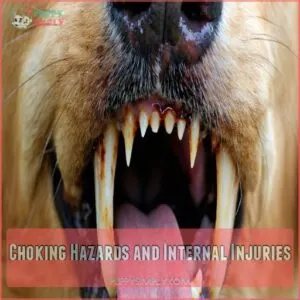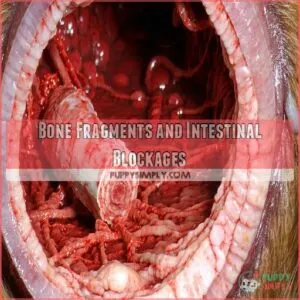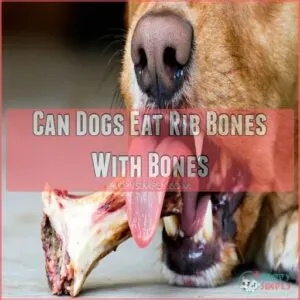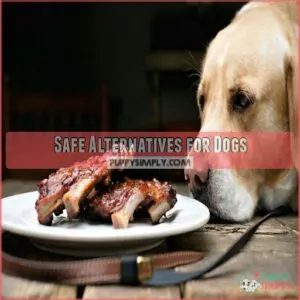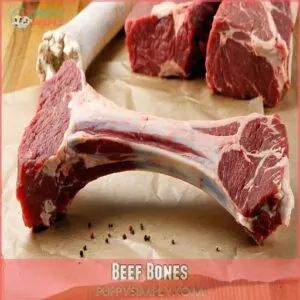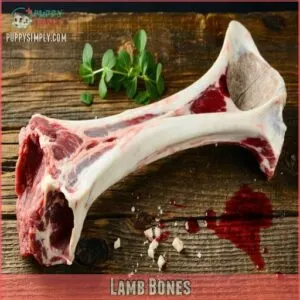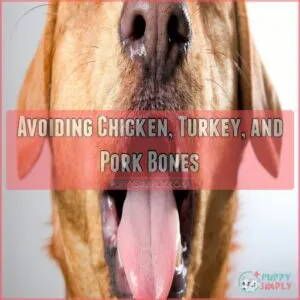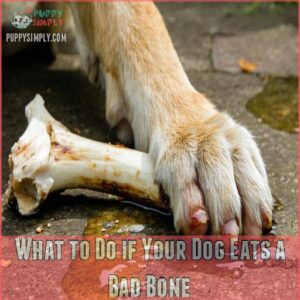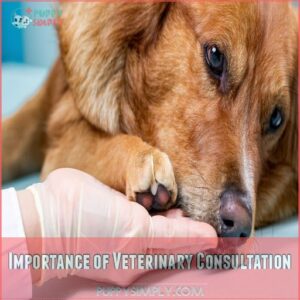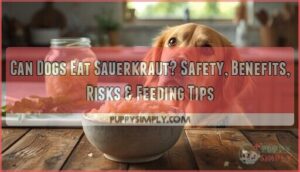This site is supported by our readers. We may earn a commission, at no cost to you, if you purchase through links.
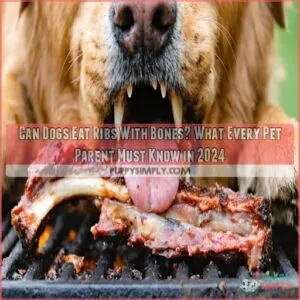
While those puppy eyes might be irresistible during your BBQ feast, rib bones pose serious risks to your furry friend.
When chewed, these bones can splinter into sharp fragments, potentially causing choking, internal injuries, or life-threatening intestinal blockages.
Even raw rib bones, which can contain harmful parasites like Trichinella bacteria risks, aren’t safe – they can harbor dangerous bacteria and lead to severe digestive issues.
That juicy rack of ribs might seem like the perfect treat, but your dog’s health isn’t worth the risk.
Instead, there are specially designed chew toys and treats that’ll keep your pup happy and healthy.
Table Of Contents
- Key Takeaways
- Risks of Feeding Rib Bones to Dogs
- Can Dogs Eat Rib Bones With Bones
- Safe Alternatives for Dogs
- Types of Bones Can Dogs Eat Safely
- What to Do if Your Dog Eats a Bad Bone
- Importance of Veterinary Consultation
- Frequently Asked Questions (FAQs)
- Which Bones is your dog allowed to eat?
- Are beef rib bones okay to give a dog?
- Are rib bones bad for dogs?
- Why do dogs like bones?
- What bones can dogs eat from butchers?
- What type of bones should dogs not eat?
- What is the best bone for a dog?
- Can I give my puppy bones to chew?
- How long should I let my dog chew a bone?
- Do bones splinter when eaten?
- Can I Give My Dog Rib Bones?
- Are rib bones safe for dogs to chew?
- What happens if a dog eats a bone from ribs?
- Can dogs eat cooked pork ribs?
- What kind of bones can dogs eat?
- How long does it take for bone fragments to pass?
- Can puppies and senior dogs handle bones differently?
- Do different dog breeds have varying bone tolerance?
- Is smoked meat more dangerous than regular cooking?
- What size bones match my dogs weight?
- Conclusion
Key Takeaways
- Don’t give your dog rib bones; they can splinter and cause serious internal injuries like choking or intestinal blockages.
- Rib bones, whether cooked or raw, pose a significant risk due to their potential to break into sharp fragments.
- Your dog’s health is at risk from pancreatitis due to the high fat content in ribs, particularly pork ribs.
- Opt for safer alternatives like durable chew toys and veterinarian-approved dental treats to satisfy your dog’s chewing instincts.
Risks of Feeding Rib Bones to Dogs
You might think you’re treating your dog by sharing those tasty rib bones, but you’re actually putting them at risk for serious health problems like choking, internal injuries, and digestive blockages.
While your furry friend’s puppy-dog eyes can be hard to resist, you’ll need to know why these bones can be dangerous before deciding whether to share them.
Choking Hazards and Internal Injuries
Your dog’s powerful jaws can turn a seemingly harmless rib bone into dangerous shards.
These splintered pieces are like tiny daggers, capable of puncturing their mouth, tongue, and internal organs.
When bone fragments lodge in their throat, they create a life-threatening choking hazard.
For more information on the risks associated with dog rib bones, check out the products related to dog rib bone dangers.
Think of it this way: what starts as a simple treat could end in an emergency vet visit or internal bleeding.
Pancreatitis and Digestive Issues
When dogs chow down on rib bones, they’re biting off more than just a tasty treat.
The high fat content in these bones, especially pork ribs, can trigger pancreatitis – a serious inflammation of the pancreas.
Even if you’ve been cooking those ribs to perfection, the heating process actually concentrates the fat content, making them even riskier for your furry friend’s digestive system.
Bone Fragments and Intestinal Blockages
Beyond the risks of pancreatitis, bone fragments can create life-threatening blockages in your dog’s digestive system.
Think of it like a clogged drain – except this backup requires immediate surgery for removal.
It’s important to remember that even cooked rib bones pose a serious threat, as they can splinter into sharp fragments, leading to severe internal damage.
Here’s what happens when bone fragments cause intestinal blockages:
- Food can’t pass through properly, leading to severe abdominal pain
- Blood flow gets restricted to vital organs
- Tissue starts dying within hours
- Emergency surgery becomes the only option for survival
Can Dogs Eat Rib Bones With Bones
Feeding dogs rib bones, which can cause serious health issues like intestinal blockages and choking, isn’t worth the risk, no matter how much they beg.
While raw bones are slightly safer than cooked ones, they still pose significant dangers.
Think of rib bones like tiny daggers – they can splinter into sharp fragments that tear through your dog’s digestive system.
Even raw pork ribs pack too much fat, potentially triggering pancreatitis.
The bottom line? Skip the bones altogether.
Instead, if you want to share ribs with your furry friend, stick to small amounts of lean, unseasoned meat removed from the bone.
Safe Alternatives for Dogs
You’ll be relieved to know there are plenty of safe alternatives to ribs that can satisfy your dog’s natural urge to chew.
Chew toys and veterinarian-approved dental treats can protect your furry friend while still letting them enjoy their chewing instincts.
Frozen Treats in Durable Chew Toys
Rottweilers’ natural instinct to chew on bones, such as raw beef bones, can be a great way to stimulate their minds and clean their teeth, but it’s crucial to choose the right type of bone to avoid any risks. Savvy pet parents regularly turn to frozen treats in durable chew toys as a safer alternative to risky rib bones. You’ll protect your pup while satisfying their natural urge to chew.
Here’s what makes frozen treats in sturdy toys a game-changer:
- They’re tough enough to withstand powerful jaws
- The cold soothes teething discomfort
- Fill them with low-fat yogurt or pumpkin puree
- Freezing extends playtime considerably
- They’re washable and reusable, saving you money
Long-Lasting Chew Bone Treats
While store-bought chew bone treats offer a safer alternative to ribs, you can also explore a wide range of options available at online stores like dog chew bones.
Look for trusted brands like Nylabone or KONG that offer long-lasting options specifically designed for your dog’s size and chewing style.
These treats can keep your pup entertained for hours while promoting dental health through gentle abrasion.
Always supervise your dog and replace treats when they become small enough to swallow.
Raw Bones for Dental Health
Through careful selection, raw bones that are not cooked bones risks can support your dog’s dental health when chosen wisely.
Consider these proven dental benefits that raw bones provide:
- Natural plaque removal through controlled chewing action
- Strengthened jaw muscles from extended gnawing sessions
- Reduced tartar buildup along the gumline
But don’t rush to the butcher just yet. Raw bones require strict supervision and vet approval, especially for dogs with existing dental issues or aggressive chewing habits.
Types of Bones Can Dogs Eat Safely
You’ll need to be extra careful when choosing bones for your dog, as not all types are created equal in terms of safety.
While large, raw beef and lamb bones can be suitable options for your furry friend, you must avoid chicken, turkey, and pork bones entirely since they’re prone to splintering and causing serious internal injuries.
Beef Bones
Raw beef bones can be safe for your dog, but you’ll need to follow some important rules.
Here’s what you should know about beef bones, based on size and preparation:
| Bone Type | Safety Level | Benefits | Risks |
|---|---|---|---|
| Raw marrow | High | Dental health | Digestive upset |
| Raw knuckle | High | Mental stimulation | Tooth damage |
| Cooked any | Low | None | Splintering |
| Processed | Very low | None | Choking hazard |
Remember: always supervise your pup during chewing sessions.
Lamb Bones
When talking about lamb bones, think of them as similar to beef bones in terms of density and safety profile.
You’ll find they’re generally safe for your furry friend when served raw and appropriately sized.
However, it’s important to remember that dangers of lamb bones like bacterial contamination and splintering can still pose a risk if not handled correctly.
- Large, raw lamb bones can support healthy chewing habits
- The density helps prevent dangerous splintering
- Thick marrow bones provide mental stimulation
- Shoulder bones work well for larger breeds
- Avoid giving small or narrow cuts that could pose risks
Avoiding Chicken, Turkey, and Pork Bones
You’ve probably heard those old tales about giving dogs chicken bones, but here’s the truth: chicken, turkey, and pork bones are absolute no-gos for your pup.
These bones can splinter like glass, causing serious internal damage.
Unlike beef or lamb bones, poultry bones are hollow and brittle, while pork bones are dense yet prone to shattering.
Instead, consider opting for safe and durable alternatives like dog chew bones online.
It’s just not worth the risk to your four-legged friend’s safety.
What to Do if Your Dog Eats a Bad Bone
If you’ve caught your dog eating a dangerous bone, such as a sharp-edged pork femur bone that can cause choking or intestinal blockage, you’ll need to act quickly to prevent potential health emergencies.
While it’s natural to panic in this situation, knowing the right steps to take and warning signs to watch for can make the difference between a close call and a serious medical crisis.
3 Immediate Steps to Take
Panic can cloud your judgment when your dog swallows a dangerous bone. Here’s what you need to do right away:
- Stay calm and assess if your dog is actively choking – check for coughing, gagging, or difficulty breathing
- Don’t force anything out of their throat – this could cause more damage
- Call your veterinarian immediately for professional guidance
- Keep your dog’s movement restricted until you get help
Monitoring Your Dog for Signs of Illness
After your dog swallows a dangerous bone, watch closely for trouble signs over the next 48 hours.
Your pup may show vomiting, lethargy, or abdominal bloating – all red flags that need immediate vet attention.
If they’re not eating or showing signs of constipation, don’t wait to make that call.
Trust your gut – it’s better to be overly cautious than risk your furry friend’s health.
Checking for Bone Fragments in Stool
While monitoring your dog’s health, keep a close eye on their stool for the next 48-72 hours.
Watch for bone fragments passing through – they’ll appear as white or light-colored pieces in the waste.
If you don’t spot any fragments after three days, or if you notice blood, mucus, or your dog straining, contact your vet immediately.
Keep a record of what you find.
Importance of Veterinary Consultation
You’ll want to consult your veterinarian before feeding your dog any type of bones, as they can provide specific guidance based on your pet’s size, age, and health condition.
If you’re ever unsure about what’s safe for your dog to eat, it’s better to make that quick call to your vet than risk a costly emergency visit later.
Seeking Advice on Safe Foods and Treats
Your veterinarian’s a goldmine of knowledge regarding safe treats for your pup.
They’ll help you navigate the confusing world of dog food brands and treat options, tailoring recommendations to your dog’s specific needs.
Book a routine check-up to discuss your dog’s diet – from raw food safety to homemade treats.
They’ll steer you away from risky choices and toward options that keep your furry friend happy and healthy.
Immediate Veterinary Attention for Emergencies
Don’t hesitate when emergencies strike – every second counts.
If your dog shows signs of choking, distress, or unusual behavior after eating bones, get to an emergency vet immediately, especially if they’re displaying symptoms similar to dog limping back leg.
Watch for red flags like drooling, gagging, vomiting, or restlessness.
Emergency clinics are equipped to handle bone-related complications 24/7, and quick action could save your pet’s life.
Remember, it’s better to be overly cautious than regretful later.
Educating Yourself on Potential Risks
Taking charge of your pet’s safety starts with understanding what could harm them.
After handling emergencies, prevention becomes your best defense.
Here’s what responsible pet parents should know about dangerous treats:
- Raw bones can harbor harmful bacteria
- Cooked bones, being more brittle, can pose serious risks similar to those of raw pork bones, splinter and cause internal damage
- Marrow-rich bones may trigger digestive issues
- Holiday leftovers often contain hidden toxins
- Even "dog-safe" treats need size-appropriate selection
Learning these risks helps you make smarter choices for your furry friend’s wellbeing.
Frequently Asked Questions (FAQs)
Which Bones is your dog allowed to eat?
Raw beef and lamb bones, when large and thick, are safe options for your dog to chew.
Bones including cooked bones of any kind, chicken, turkey, and pork bones, aren’t safe due to splintering risks.
Are beef rib bones okay to give a dog?
You shouldn’t give your dog beef rib bones, cooked or raw.
They can splinter, causing serious internal injuries or choking.
Instead, try safer alternatives like durable chew toys or veterinarian-approved dental treats.
Are rib bones bad for dogs?
Nearly 80% of veterinary emergencies from bones involve rib bones.
Don’t give your dog rib bones – they’re dangerous choking hazards that can splinter, causing internal injuries and potentially fatal blockages in your pet’s digestive system.
Why do dogs like bones?
Dogs instinctively crave bones because they’re programmed to seek out marrow’s rich nutrients.
It’s in their DNA from wolf ancestors, who’d hunt and devour prey completely.
They’ll chew to satisfy this primal urge.
What bones can dogs eat from butchers?
Raw beef knuckle bones and large marrow bones from trusted butchers can be safe for your dog.
Avoid cooked bones and small cuts that could splinter.
Always supervise and consult your vet first.
What type of bones should dogs not eat?
You shouldn’t feed your dog cooked bones, chicken bones, turkey bones, or pork rib bones. These can splinter easily, causing choking or internal injuries. Stick to vet-approved chew toys instead.
What is the best bone for a dog?
Large, raw beef marrow bones are your safest choice for a dog’s chewing needs.
They’re durable, won’t splinter easily, and satisfy natural urges.
Just supervise and remove when they become small enough to swallow.
Can I give my puppy bones to chew?
While those puppy dog eyes might tempt you, bones aren’t safe for your little friend.
Instead, opt for specially designed puppy chew toys that’ll protect their teeth and satisfy their natural urge to chomp.
How long should I let my dog chew a bone?
Never leave your dog unsupervised with a bone.
Limit chewing sessions to 10-15 minutes max to prevent overexertion and damage to teeth.
Remove the bone if it becomes small enough to swallow.
Do bones splinter when eaten?
Yes, bones can definitely splinter when eaten, especially cooked ones.
You’ll notice they break into sharp, dangerous fragments that can seriously harm your dog’s mouth, throat, and digestive system.
It’s not worth the risk.
Can I Give My Dog Rib Bones?
Don’t give your dog rib bones – they’re dangerous and can splinter, causing serious internal injuries.
Instead, try safe alternatives like durable chew toys or veterinarian-approved dental treats for their chewing satisfaction.
Are rib bones safe for dogs to chew?
While your dog might love chomping on rib bones, they’re actually quite dangerous.
Both raw and cooked bones can splinter, causing serious injuries.
Instead, try special dog chew toys for a safe chewing experience.
What happens if a dog eats a bone from ribs?
Rib bones can splinter in your dog’s digestive system, causing serious injuries like choking, internal bleeding, or intestinal blockages.
You’ll need immediate veterinary care if you notice vomiting, lethargy, or bloody stool.
Can dogs eat cooked pork ribs?
Cooked pork ribs pose serious dangers to your dog’s health.
The bones can splinter, causing choking or internal injuries, while the fatty meat raises pancreatitis risks.
Stick to vet-approved treats instead.
What kind of bones can dogs eat?
Dogs can safely chew on large, raw beef or lamb bones, as these are less likely to splinter.
Avoid cooked bones and steer clear of small, narrow ones that can easily break and cause harm.
How long does it take for bone fragments to pass?
Think of your dog’s stomach as a slow-moving traffic jam; bone fragments usually pass within 48 to 72 hours.
Keep an eye on their stool and watch for any trouble signs like bloating, vomiting, or discomfort.
Can puppies and senior dogs handle bones differently?
Puppies and senior dogs have weaker teeth and more delicate digestive systems.
They’re more prone to choking and blockages from bone fragments.
It’s important to choose softer, vet-approved chew alternatives designed for their specific needs.
Do different dog breeds have varying bone tolerance?
Certainly, different dog breeds show varying bone tolerance.
Some breeds, like Labradors, have stronger jaws, handling bones better than smaller breeds like Chihuahuas.
Always consult your vet to make sure bone safety is right for your dog’s breed.
Is smoked meat more dangerous than regular cooking?
Smoked meat‘s high fat content and potential seasoning dangers make it riskier for dogs than regular cooking methods.
The smoke process can add carcinogens, further complicating things.
Keep smoked meat away from your furry friend to avoid health issues.
What size bones match my dogs weight?
Choose bones that are big enough to prevent swallowing but not too hard to break teeth.
For a medium-sized dog, opt for large raw bones like beef knuckles, avoiding small or cooked bones to make sure safety.
Conclusion
Remember, your dog’s health is paramount.
Avoid the temptation; can dogs eat ribs with bones? Absolutely not.
Those splintering bones pose serious risks, from choking to internal injuries.
Choose safer alternatives: durable chew toys or long-lasting treats.
Prioritize your pet’s well-being; it’s always better to err on the side of caution.
Consult your vet if you have questions about safe snacks or notice any concerning symptoms after your furry friend accidentally ingests something unsafe.
Your pup will thank you for it.

